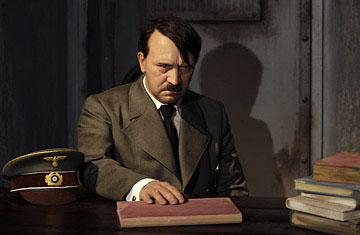
A waxwork of Adolf Hitler before a 41-year-old man tore its head off from the controversial exhibit on the opening day of Berlin's Madame Tussauds.
Until last week, Frank L. was an unknown 41-year old former policeman who worked in geriatric care to supplement his meager welfare stipend, and in his spare time enjoyed an occasional beer at the pub. Last Saturday, though, a moment of vandalism turned Frank L. into something of a national hero, mentioned by some in the same breath as the legendary Claus Schenk Graf von Stauffenberg, who led a failed assassination attempt against Hitler in 1944. Frank L. accomplished his extraordinary rise from obscurity to national celebrity through a simple act of decapitation.
Three minutes after the opening of the new Madame Tussauds in Berlin, Frank L., who had been second in the line to enter the waxwork museum, stormed past security and toward an exhibit that had aroused controversy during the weeks prior to the opening: a wax figure of Adolf Hitler, depicting the dictator as a broken man, sitting behind his desk during his last days in the "Führerbunker." The attacker shouted "No more War!" several times, while tackling the figure, and managed to yank off its head before being seized by the police.
Instead of condemning Frank L.'s action, many Germans expressed admiration for his attack. One commentator raved, "75 years after the 'seizure of power' and 63 years after the end of the Third Reich, finally an assassination attempt against Hitler succeeded ... a 41 year-old Berliner accomplished what Johann Georg Elser, Claus Schenk Graf von Stauffenberg ... and many others paid with their lives: he decapitated Hitler..." Even the policeman answering the questions of the gathered journalists at the scene of the crime couldn't suppress a gleeful smile when he announced: "Speaking as a human being, the attack was successful".
It turns out that Frank L. had been dared by his pub mates the previous night to destroy the waxen Hitler, and he returned home, after several hours of interrogation, to a hero's welcome from his girlfriend and neighbors. The man, who describes himself as "politically left-leaning, but not extreme" and has expressed regret about his deed since, told the German left-wing daily Die Tageszeitung, "Somebody had to do something. Berlin mustn't become a pilgrimage site for neo-Nazis."
Many Berliner's had expressed similar concerns after Madame Tussauds had announced plans to feature Hitler in its waxwork collection. The museum tried to mollify critics by banning visitors from taking pictures of the exhibit, and by depicting Hitler as the broken, deranged figure in his final days as portrayed by German actor Bruno Ganz in the 2004 movie Downfall. Still, many voices, such as Johannes Tuchel, head of the German Resistance Memorial Center in Berlin, rejected the presence of a Hitler waxwork, and attacked Madame Tussauds' decision to restore it on show "as soon as possible", saying the museum was trivializing the Nazi terror.
"Hitler is not a leisure activity," Tuchel told TIME. But he said he was against putting Frank L. on a par with the likes of Stauffenberg or Elser. "Vandalism is not a argument in a political debate, of course, but on the other hand, the reaction shows how heated the debate is," Tuchel said.
But why has the arrival of a Hitler waxwork unleashed such passion in Berlin? After all, a waxen representation of the dictator has been on display in the German city of Hamburg for 60 years, without causing any serious disruptions. Some argue that it is the proximity to the site from which Hitler actually directed the Nazi terror that makes the issue particularly sensitive. But the German daily Suddeutsche Zeitung has a different theory: "Berlin cherishes a culture of civil disobedience", the newspaper wrote. Other commentators pointed out that Frank L. "of course" lived in Kreuzberg, a Berlin district known for its squatter and punk scene, and annual demonstrations and riots on May 1. The attacker told Tageszeitung that it was a demonstration on the occasion of Ronald Reagan's visit to Berlin in 1987 that prompted him to retire from his police job. "As a policeman it was my job to take action against the demonstrators," he said, "but I rather wanted to go with them."
It remains unclear what kind of legal action or punishment he'll face. "It depends on the actual damage, which remains to be assessed," said Natalie Rouss, spokeswoman of Madame Tussauds. She does not, however, believe that Frank L. will go down in German history as a national hero: "He is just not the type."
